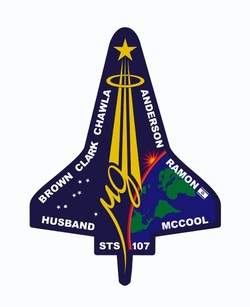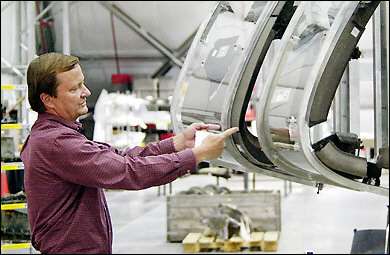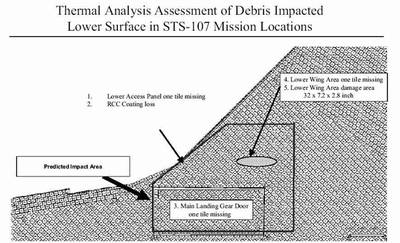Cost-Consciousness Could Have Killed Columbia
 When the
Columbia Accident Investigation Board releases its final
report, sometime before Labor Day, it will likely be a blistering
blow to NASA. The board will probably recommend major changes in
the space agency's "culture," as well as creation of an independent
body to oversee flight safety issues. But will the CAIB address the
bottom-line issues that may have contributed more than any other to
the Columbia disaster?
When the
Columbia Accident Investigation Board releases its final
report, sometime before Labor Day, it will likely be a blistering
blow to NASA. The board will probably recommend major changes in
the space agency's "culture," as well as creation of an independent
body to oversee flight safety issues. But will the CAIB address the
bottom-line issues that may have contributed more than any other to
the Columbia disaster?
We're Talking Money Here
Now, to be fair, NASA doesn't appropriate its own budget. The
space agency makes a request, it becomes part of the president's
budget and it gets mauled on Capitol Hill. Whatever Washington
sends, NASA pretty much has to live with. Budgetary constraints
were seen as a factor in the 1986 Columbia disaster. Now,
it looks like those same sort of constraints helped doom
Columbia.
The most experienced shuttle engineers in the world work at the
Boeing plant in Huntington Beach (CA). They have more than 18
years' experience in thermal applications with specific regard to
the shuttle program. But when, shortly after Columbia's
last launch on January 16th, a chunk of insulating foam broke free
of the external fuel tank and slammed into the shuttle's left wing,
NASA didn't call on the Huntington Beach team.
Why?
As ANN reported earlier this year (ANN: February 24, 2003 -
"Is Columbia Plagued By
Inexperience?"), Boeing transferred shuttle jobs to
Houston in a consolidation that has cost the company scores of its
most experienced shuttle engineers over the past two years --
including some of those who invented the methodology for debris
damage and thermal analysis.

While Columbia was still early in its mission, Boeing
managers relied on the Houston-based team of engineers who had
never done this type of analysis in a real situation.
"This was their first flight," said an anonymous Boeing thermal
systems engineer. "This was the first time they took over."
The Houston team analyzed a number of scenarios, ultimately
predicting a "safe return" for Columbia. Boeing executives say that
analysis as the "best answers possible" from the "best technical
minds." On Friday, Allen said the company "absolutely" stood by
that statement, even as new e-mails released from NASA last week
suggested some inside the agency voiced strong doubts.

The Miami Herald reported Boeing's Huntington Beach
engineers -- who helped invent the process -- say the Boeing team
in Houston grossly mis-analyzed the data.
"Basically, they just didn't interpret the numbers right," the
thermal systems engineer said. "They never properly identified the
risk."
Their interviews with The Miami Herald echo the
statements of numerous outside experts who have said the thermal
analysis were flawed. And they raise a haunting question in the
aftermath of the February 1 shuttle disintegration: Could NASA have
saved the seven astronauts had it properly assessed the risk?
After the disaster, the California engineers say they were
shocked to see the data that Boeing and NASA used to reach their
conclusions. One chart relied on a computer program called "Crater"
to come up with nine different damage scenarios. Any one of them
could have been catastrophic, the thermal engineer here said, but
the Houston analysts downplayed the results by saying that "Crater"
tended to be conservative.

"When something like that hits you and your computer program
tells you you're all the way through the thermal protection system
for that big of an area, you're in big trouble," the thermal
systems engineer said. "We had never seen a chart as bad as
that."
NASA managers have also speculated that, if there was a serious
risk of one wing falling apart, the shuttle could come in at a
slightly different angle to put more heat on the good wing.
After the crash, NASA has repeatedly tried to downplay the
possibility that damage caused by the debris that hit the orbiter's
left wing actually led to the crash. Last week, NASA Administrator
Sean O'Keefe mocked reporters for focusing so much on foam, calling
them "foamologists."
But the internal e-mails circulating among Boeing engineers in
Huntington Beach show at least some have lingering doubts.
"NASA and Boeing Management are doing whatever they can to
redirect attention away from that thermal analysis that was done by
inexperienced thermal engineers rather than the guys that would
normally have done it," it says.
Fatal Cost-Cutting?
 There are two dynamics
at play here. In the first, Congress (and therefore NASA) tightens
the budget. After all, there are many on Capitol Hill who'd just as
soon see the manned space program scrapped. They view it as a waste
of resources. NASA, therefore, cuts funding to contractors as a
result of the axe-weilding in Washington.
There are two dynamics
at play here. In the first, Congress (and therefore NASA) tightens
the budget. After all, there are many on Capitol Hill who'd just as
soon see the manned space program scrapped. They view it as a waste
of resources. NASA, therefore, cuts funding to contractors as a
result of the axe-weilding in Washington.
The second part of the equation is the NASA-think of doing
things "better, faster cheaper," as a result of the cutbacks.
Instead of re-evaluating its programs and priorities in the face of
cutbacks, NASA managers instead did all they could to cram their
original agenda into a budget three sizes too small.
Perhaps there was a sense of complacency about foam strikes on
lifting orbiters. Still, because of budgetary concerns, the best
minds capable of analyzing damage to the thermal tiles on the left
wing's leading edge were left out of the loop.
Aero-News has long supported NASA and the amazing people who
work for the space agency. That won't change. Yet, in the face of
budget constraints, the term "getting the biggest bang for the
buck" has taken on a new meaning of tragic proportions. As the CAIB
finalizes its report to America, we hope it will address the "do
more with less" attitude. Perhaps it's time for NASA to do less
with less -- and make what is done as near-perfect as possible.
 ANN's Daily Aero-Linx (04.16.24)
ANN's Daily Aero-Linx (04.16.24) Aero-News: Quote of the Day (04.16.24)
Aero-News: Quote of the Day (04.16.24) Airborne 04.10.24: SnF24!, A50 Heritage Reveal, HeliCycle!, Montaer MC-01
Airborne 04.10.24: SnF24!, A50 Heritage Reveal, HeliCycle!, Montaer MC-01 Airborne 04.12.24: SnF24!, G100UL Is Here, Holy Micro, Plane Tags
Airborne 04.12.24: SnF24!, G100UL Is Here, Holy Micro, Plane Tags Airborne-Flight Training 04.17.24: Feds Need Controllers, Spirit Delay, Redbird
Airborne-Flight Training 04.17.24: Feds Need Controllers, Spirit Delay, Redbird







